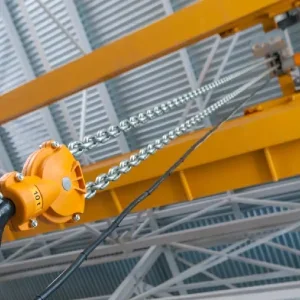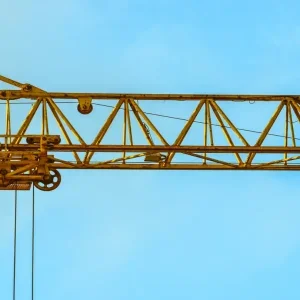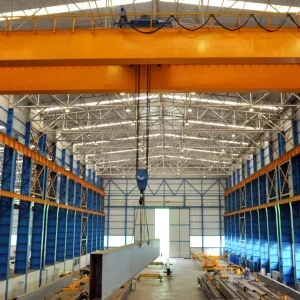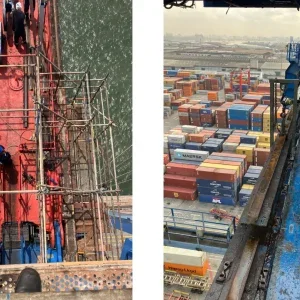There are many applications where an electric chain hoist can be used to great effect, but there can be none that are quite as specialised as in the theatres, venues and tours that make up the entertainment industry.
The average height of lift on an entertainment hoist (or motor as they tend to be called) is 20m. In industry it is generally 3m so there is a very large difference in the amount of work required from the hoist. Then there is the not inconsiderable fact that they are usually employed in an inverted position, with the hoist climbing its own chain. This is not as straightforward as it may seem. A great deal of specialised R&D work is undertaken by the main players to make sure that the details (the chain falling into a special chain collector via guide rollers, for example) are correct and that the hoist will function throughout its long life.
Time must also be spent investigating weight saving concepts. After all, the poor riggers and roadies lugging these beasts around appreciate the extra one or two kilos saved by using a cast aluminium housing, or any of the other many features employed to save weight.
No doubt most people have been to a concert or show and seen the hoists in the roof, along with the mesh of aluminium truss, wire rope suspensions and other rigging equipment that looks like a disorganised spider web. You would be mistaken to doubt exactly what the people responsible are capable of. I have met some of the most safety conscious and technically adept people within the entertainment industry. Hoists and their control are easy meat to the riggers of today. Just because the guy has long hair and a name from some sixties hallucinogenic hippy trip (Cokey, Spliffy, Wolf and others) does not mean that they are not capable of erecting a complex stage show in an arena in a matter of hours. Having worked together on projects with such riggers I can tell you they work hard and play just as hard (I have hangovers to remember them by). They are far more laid back than your average industrial project manager but when it comes to the crunch, and “the show must go on”, they are the most dedicated people you could ever work with.
There can be anything from two to 200 ‘showbiz’ hoists employed in a single show. This causes logistical problems. Transport difficulties are overcome by storing each hoist in a flight case. This is a case constructed mainly of wood (although plastic versions are becoming more common) and has wheels on each corner for rolling on and off trucks. When you see the battering these hoists take you will soon realise why another 30% of the cost of a hoist is spent on housing it while it is not in use. Believe me, a good flight case is an essential purchase with each hoist.
Hoist selection
So you have a client who wants an entertainment hoist, but which one do you choose? Major players are Verlinde and Columbus McKinnon (CM). Both have good, proven track records although the CM is beginning to show its age, having been originally manufactured in the 1950s, with little to show in the way of technical improvements. That said, the CM Lodestar is what could be classed as ‘bombproof’, in the words of one rigger I talked to recently. Older models of Verlinde motors suffered from oil leaks but the manufacturer has solved that by changing over to grease-filled planetary gearboxes, which also give smoother lifting. Couple this with a five-pocket load wheel and you get a smoother, quieter lift, which benefits any show.
Other manufacturers have tried to cash in on the increase in demand from the entertainment industry but in the experience I have had (and from the people I spoke to when researching this article) they tend not to match up to the job. Let’s face it, if you are purchasing a hoist to do 15 years of hard work and touring, are you going to go for something that is an unknown quantity? Of course not.
The opinion of the people who will be actually using the equipment is usually the one you should listen to. I spoke to two such people who said there is a place for both Verlinde and CM type hoists in the market. In the opinion of a rigger who has been in charge of between 500 and 700 hoists in his time with one of Europe’s leading rigging companies: “The CM is the fashionable hoist in the UK and is an excellent choice for a standard rigging application. The reason for this is the simple although somewhat aged construction.” He continued: “Verlinde on the other hand are lighter, smoother and quieter due to the enhancements given by a more modern design. Perfect for a venue where noise must be kept to a minimum.” So it really is down to user preference. Some prefer one to the other and some prefer different manufacturers but I can only comment on what I consider the mainstay of the industry – not so different from an industrial application then.
Okay, so now you have your hoists. Industrial hoists have pendant controls (known as pickles in the entertainment industry, don’t ask me why because I don’t know either). But you cannot have 80 pendants hanging down out of the roof of your venue to ground level while U2 (or whoever) are belting out their best. It wouldn’t really look the part would it. So you unplug them when the hoists are in position right? No, that is just impractical. Now this is the masterstroke – they control them in a host of different ways, using what is known as distro (derived from distribution).
In its simplest form distro is a multiple pendant control. A four way controller, for example, is similar to four pendant controls put into one box. It is a little more complex but you get the drift. A four-way direct control distro has a lead from each hoist (as standard the power cable). These are fed into the distro. This is then fed to four switches which operate in up and down motions. This then switches the phases in the hoist, making the motor go in one direction from the other – up or down. Simple, isn’t it? Well not really, because there is more to it than that when 80 or so hoists are to be controlled.
So how do we do 80 ways of control? One method is to link 20, four-way controls together. This gets a little scary with lengths of cable everywhere, so technology has been embraced and it is possible to control all 80 hoists, simultaneously via a laptop computer. The other possibility is to programme your show complete with scenery changes, and any other hoisting you want to carry out during a show. Computerised control is the way forward and there are even touch screens available so you group your hoists and have complete control of your show.
Couple that with the ability to read the exact position and loading on each hoist and you have a touring show controlled in a package that fits in with your truss, lights and other items.
The thing about the entertainment industry is that it is so fluid and flexible that it has to embrace technology to make sure that shows and tours go ahead smoothly and safely. Audiences have to be safe while lighting and truss are suspended above them. This is why it is a specialist industry and people intending to take on the supply of equipment should have experience in the field before just supplying any old hoist. Specifications and strict regulations must be followed to the letter as it is big news and bad news when a show goes wrong because someone supplied a hoist that burned out half way through a 25m lift.
I am lucky enough to have served companies that work in industrial sectors and others that work in the rigging of entertainment products. Currently I have the best of both worlds as I sell to both industries. Believe me when I say that they are both very different and specialised. If you take my advice you will take your quotation to a specialist supplier who will furnish you with all the correct equipment. There are many around the world who specialise in the supply of this type of kit and you will probably save time and money doing so. After all you wouldn’t trust your overhead crane to a theatre technician would you? Martin Green is sales and marketing manager at G Bridgehouse & Company, the UK Verlinde distributor for both entertainment and industrial products






